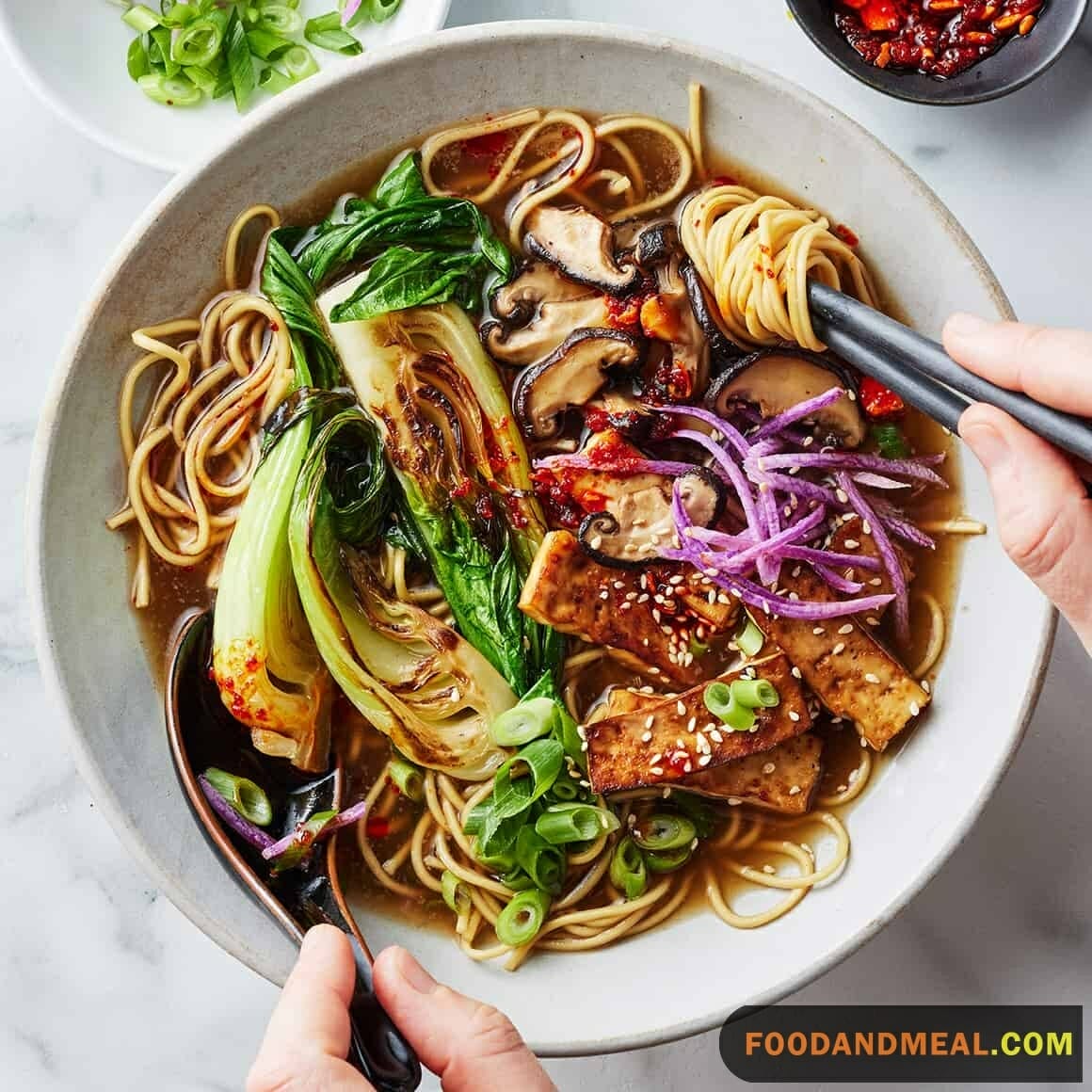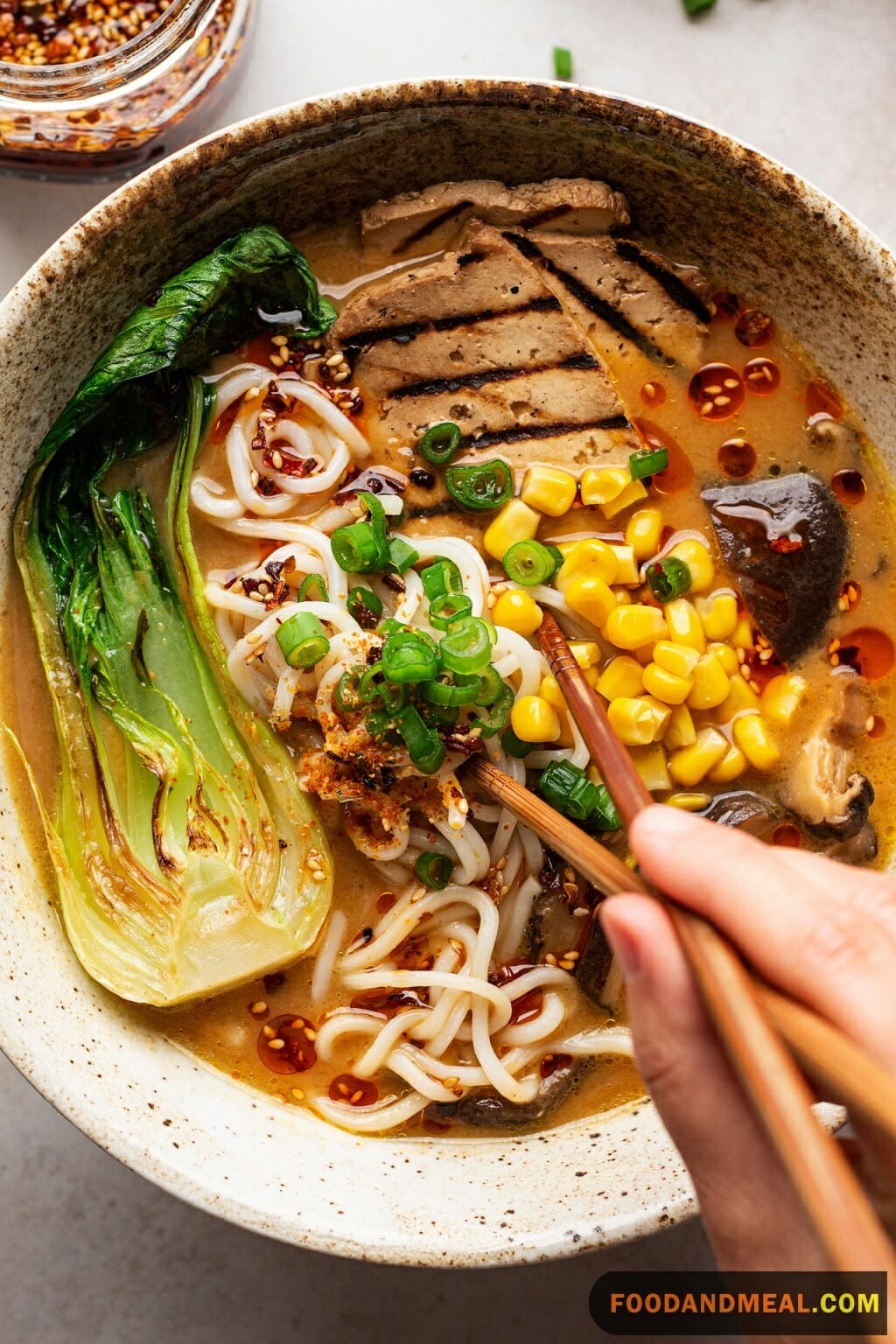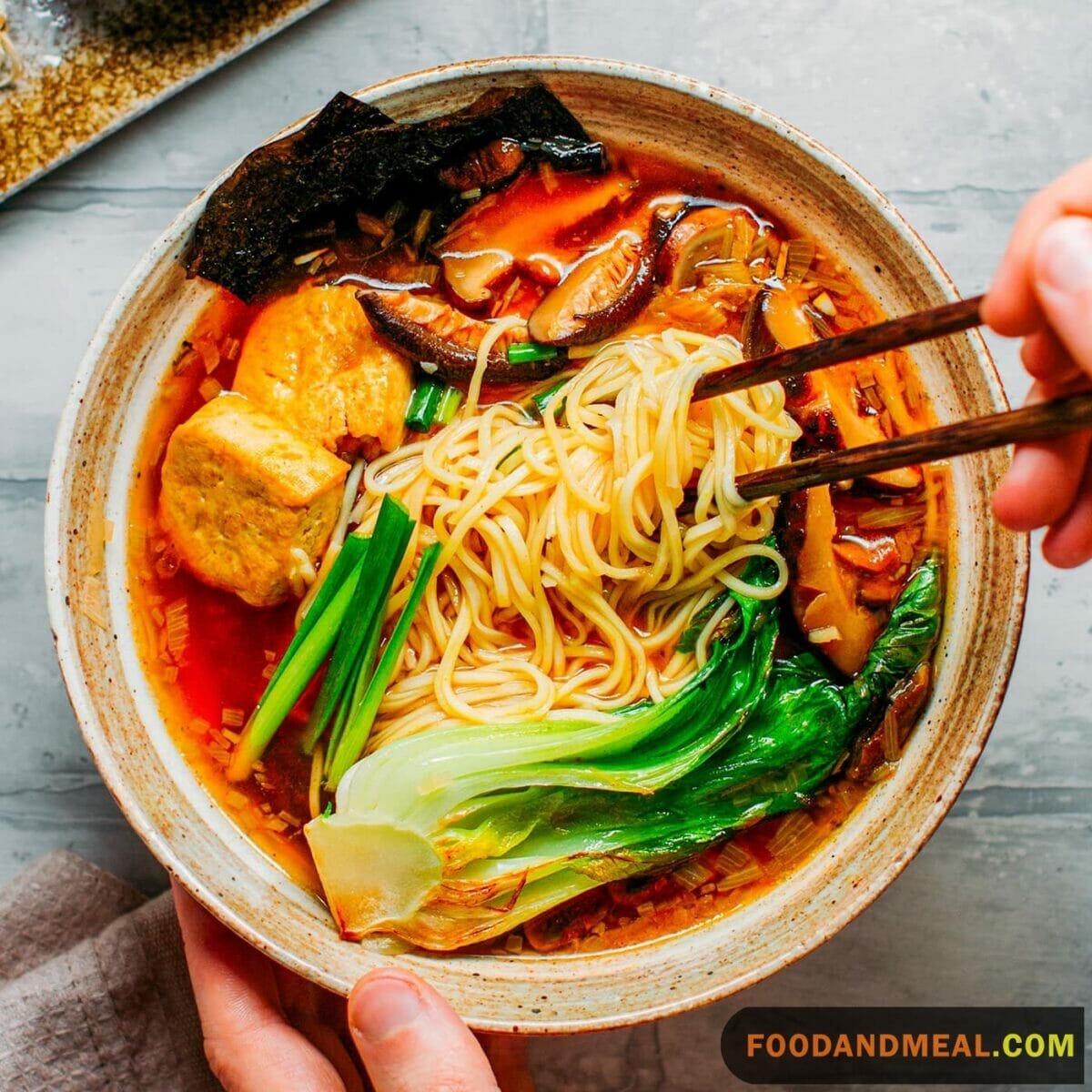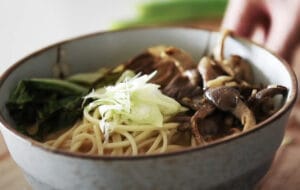As a handsome chef at Food And Meal, I’m always looking for new and exciting vegetarian recipes to share with our readers. Lately I’ve become a bit obsessed with ramen. There’s just something so comforting about a big bowl of noodles and broth. I’ve tried making vegetarian ramen a few times in the past, but have never been fully satisfied with the results.
The other day I came across an amazing noodles recipe for healthy vegetarian ramen from my partner. As soon as I saw the ingredients list I just knew this was going to be perfect – rich and flavorful with the perfect texture from the soy milk. I immediately cleared my schedule and gathered my ingredients.
When that first spoonful of broth hit my tongue, I was transported. The savoriness of the miso and dashi mingled with the slight sweetness of the soy milk, it was absolute perfection. As I slurped up those wavy noodles and crunchy bok choy, I felt so content and happy. This is exactly the kind of cozy, hearty meal I want to enjoy all winter long.
I cannot wait to share this wonderful Vegetarian Ramen Recipe with the Food And Meal audience. As a chef and ramen lover, this one really ticks all the boxes for me. The flavors are complex yet comforting, and it comes together so easily. I know our readers will be as obsessed with this creamy, dreamy ramen as I am! Let me know what you think once you give it a try!
Best Vegetarian ramen Recipes
Vegetarian ramen is not hard to make, either. You can follow the same recipe as for regular ramen, but substitute the meat stock for vegetable broth. The flavor will be different, but you can also use aromatics and spices to make the ramen taste great. Vegetarian noodle recipes are just as flavorful as those made with meat broth. The main secret is to use vegetables that aren’t too sour and have a slightly salty taste.
Vegetarian ramen soup can be served in 15 minutes. If you’re short on time, consider making the broth in advance. If you have leftover noodle broth, you can add them to the bowl once the noodles are cooked. A few more minutes will make it even more satisfying. This vegetarian ramen soup recipe is perfect for a quick weeknight meal. The ingredients are very simple and fast to make, and it can be made ahead of time.


Vegetarian Ramen
Equipment
Ingredients
- 4 baby bok choy
- 4 5 oz. packages ramen noodles
- 1 tablespoon soy sauce
- 4 cloves garlic
- 8 shiitake mushrooms dried
- 1 piece kombu dried
- ¼ cup vegetable oil
- 12 '' knob ginger
- 1 tablespoon black sesame seeds
- Kosher salt
- 4 scallions
Instructions
- Cook the garlic and ¼ cup of the oil in a medium saucepan over medium heat, frequently whisking until the garlic is translucent around 4 minutes.

- Mix in the sesame seeds and roast until the garlic is nicely browned and crisp, turning periodically for about 2 minutes.

- Heat the remaining 2 tablespoons of the oil to moderate in the preserved pot.

- Cook the sliced scallions and ginger for about 4 minutes, stirring regularly, until the scallions are crispy in patches.

- Insert the kombu and mushrooms, then whisk in 5 cups of cold water.

- Add oil a slice at a time, until introducing more, whisking to mix with each addition.

- Add the soy sauce and stir; sprinkle with salt. Lower the heat and stay warm until ready for serving.

- Spoon the liquid over the pasta to eat, then finish with the bok choy and the preserved garlic oil. If needed, finish with nori, eggs, and coriander.

Video
Notes
Nutrition
© Food And Meal
This website provides approximate nutrition information for convenience and as a courtesy only. Nutrition data is gathered primarily from the Spoonacular Database, whenever available, or otherwise other online calculators.
Instant Pot Vegetarian Ramen Noodles Recipe

Ingredients:
- 2 tablespoons oil
- 1 onion, chopped
- 2 cloves garlic, minced
- 1 tablespoon ginger, grated
- 4 cups vegetable ramen broth
- 2 tablespoons soy sauce
- 1 tablespoon miso paste ( miso broth )
- 2 carrots, sliced
- 2 cups sliced shiitake mushrooms
- 2 cups chopped bok choy
- 2 packs (7 oz each) instant ramen noodles
- Salt and pepper to taste
- Toppings of your choice (green onions, bean sprouts, soft-boiled eggs)
Instructions:
- Set your best Instant Pot to the “Sauté” function and heat the oil. Add the chopped onion and sauté for a few minutes until it becomes translucent.
- Stir in the minced garlic and grated ginger and cook for an additional minute until fragrant.
- Pour in the vegetable broth, soy sauce, and miso paste. Stir to combine.
- Add the sliced carrots, shiitake mushrooms, and bok choy to the pot. Season with salt and pepper.
- Close the Instant Pot and set it to “Manual” for 5 minutes. Make sure the vent is set to sealing.
- When the timer goes off, carefully release the pressure using the quick-release valve.
- Open the Instant Pot and add the instant ramen noodles. They will cook quickly in the hot broth, usually within a few minutes. Be cautious not to overcook them; they should be slightly firm.
- Serve your Instant Pot Vegetarian Ramen hot, garnished with your choice of toppings like green onions, bean sprouts, or soft-boiled eggs.
About Vegetarian ramen broth
Creating a vegetarian ramen broth is an art form that can stir up a whirlwind of emotions, much like painting a canvas or composing a melody. The process is not just about following a recipe; it’s about infusing the broth with love, care, and personal touches that make each sip feel like a warm embrace.
The foundation of a good vegetarian ramen broth lies in its ingredients. Imagine a pot simmering gently on the stove, filled with the earthy tones of vegetable stock, the zesty kick of ginger, the subtle sharpness of onion, and the rich, umami depth provided by garlic and dried shiitake mushrooms. These ingredients come together to create a symphony of flavors that dance on the palate, offering comfort and nourishment.
As you prepare the broth, there’s a sense of anticipation that builds within you. The aroma fills the kitchen, a reminder of the transformative power of cooking. It’s not just about sustenance; it’s about creating something that has the potential to turn a bad day into a good one, to bring a smile to a weary face, to offer solace in a bowl.
Personal opinions may vary, but for many, the act of making ramen broth from scratch is a meditative experience. There’s a connection to the food that can’t be replicated by store-bought options. It’s the difference between a handwritten letter and a text message – both convey the message, but one carries the weight of personal touch and effort.
The beauty of vegetarian ramen broth is its versatility. You can tweak the recipe to suit your taste buds or to reflect the seasons. In the fall, a dash of miso paste adds a comforting warmth, while in the summer, a hint of citrus can bring a refreshing lightness to the dish.
And let’s not forget the emotional aspect of food. Cooking is often intertwined with our feelings. A bowl of homemade ramen can be a celebration, a remedy for sadness, or a way to express love. The emotions we pour into our cooking imbue the food with something intangible yet profoundly impactful.
Vegetarian ramen seasoning is a symphony of flavors that can transform a simple bowl of noodles into a soul-warming experience. The essence of this seasoning lies in its ability to evoke the umami-rich depth traditionally found in ramen, without relying on any animal products. It’s a testament to culinary creativity and a beacon for those seeking plant-based comfort food.
The foundation of vegetarian ramen seasoning often starts with a blend of aromatic alliums like onion and garlic, which are dehydrated to concentrate their flavors. These ingredients form the backbone of many instant noodle seasonings, but for the vegetarian version, they’re free from the usual suspects like “powdered cooked chicken” or “dehydrated beef extract” that are almost ubiquitous in non-vegetarian packets.
When crafting homemade vegan ramen seasoning, the inclusion of shiitake mushroom powder is a game-changer. It imparts an earthy, meaty note that’s incredibly satisfying. The addition of vegetable broth powder further enriches the mix, creating a base that’s both hearty and complex. Spices such as ginger add warmth and a gentle kick, while toasted sesame seeds bring a subtle nuttiness to the palate.
Personal touches can elevate the seasoning even more. A sprinkle of chili powder or paprika can introduce a gentle heat that dances on the tongue, while a pinch of fine sea salt sharpens the overall profile. For those who enjoy a touch of sweetness, coconut sugar offers a caramel-like undertone that balances the savory elements beautifully.
The true beauty of vegetarian ramen seasoning lies in its versatility. It’s a canvas for personal expression. Whether you prefer a broth that’s bold and spicy or one that’s milder and more nuanced, the power is in your hands. You can adjust the levels of each ingredient to suit your taste, making each bowl a reflection of your own culinary preferences.
Emotionally, there’s something deeply comforting about tucking into a bowl of ramen that’s been seasoned with care and consideration for both flavor and ethics. It’s a guilt-free indulgence that doesn’t compromise on taste. The rich, layered flavors of vegetarian ramen seasoning can stand proudly alongside their traditional counterparts, offering a heartwarming embrace to vegetarians, vegans, and even meat-eaters looking to explore the vibrant world of plant-based cuisine.
Ingredients
- Dehydrated onion powder
- Dehydrated garlic powder
- Shiitake mushroom powder
- Vegetable broth powder
- Ground ginger
- Toasted sesame seeds
- Chili powder or paprika (optional, for heat)
- Fine sea salt
- Coconut sugar (optional, for sweetness)
Direction:
To make vegetarian ramen seasoning, you’ll want to start by gathering a blend of aromatic alliums such as onion and garlic. These should be dehydrated to concentrate their flavors, which will form the backbone of your seasoning mix. Avoid using any animal product derivatives like powdered cooked chicken or dehydrated beef extract that are common in non-vegetarian seasonings.
Next, incorporate shiitake mushroom powder for an earthy, meaty note that brings a satisfying umami flavor. Add vegetable broth powder to enrich the mix and create a hearty and complex base. Spices such as ginger can be included for warmth and a gentle kick, while toasted sesame seeds will contribute a subtle nuttiness.
For personal touches, consider adding chili powder or paprika if you enjoy a bit of heat, and fine sea salt to enhance the flavor profile. If you like a hint of sweetness, coconut sugar can provide a caramel-like undertone that complements the savory aspects of the seasoning.
Remember, the beauty of making your own vegetarian ramen seasoning is the ability to adjust the levels of each ingredient to match your personal taste preferences. Whether you prefer bold and spicy or mild and nuanced, you can tailor the seasoning to your liking.
- Begin with dehydrated onion and garlic powder as your base.
- Add shiitake mushroom powder for umami depth.
- Mix in vegetable broth powder for richness.
- Include spices like ground ginger for warmth.
- Toasted sesame seeds add a nutty flavor.
- Adjust heat with chili powder or paprika to your preference.
- Fine sea salt sharpens the flavors.
- Optional: coconut sugar for a touch of sweetness.
Combine these ingredients in a bowl and mix well. Store your homemade easy vegan ramen seasoning in an airtight container, and use it to season your ramen broth to taste. Enjoy the comfort of knowing that your veggie ramen is not only delicious but also compassionate and plant-based.
Tips for making Easy Vegan Ramen

Cooking Tips
- Sauté First: Sautéing the onion, garlic, and ginger before pressure cooking enhances the flavors.
- Quick-Release Veggies: Use the quick-release valve when cooking vegetables to prevent overcooking.
- Noodle Timing: Add the instant vegan ramen noodles at the end to keep them from getting mushy; they cook quickly in the hot broth.
- Overcooking Noodles: Be cautious not to overcook the noodles; they should be slightly firm when served.
- Skipping Sautéing: Don’t skip the sauté step; it’s essential for building the rich flavors in your broth.
- Ignoring Quick Release: Releasing pressure too slowly can lead to overcooked vegetables. Be prompt with the quick-release valve.
Serving Suggestions about easy vegetarian ramen recipe
Pairing the right side dish with our vegetarian ramen can elevate the meal to new heights of flavor and satisfaction. While the ramen itself is a hearty and complete dish, adding a side can provide a delightful contrast in textures and tastes.
- For those who enjoy a touch of freshness with their vegan ramen, consider serving it alongside a simple salad like the Mesclun and Artichoke Salad or a Greek Veggie Mix. The crispness of the greens will complement the richness of the veggie ramen broth beautifully.
- If you’re looking for something more substantial, Whole Wheat Cheese Toast or Grilled Panini with Vegetables can add a satisfying crunch and an extra dose of veggies to your meal. These options are particularly great for those chilly days when you want something warm and toasty on the side.
- For a lighter option that still packs a punch of flavor, the Japanese Green Tea Rice could be a unique and aromatic accompaniment. Its subtle tea-infused flavor would not overpower the vegan ramen but instead offer a gentle, earthy note.
- Lastly, if you’re in the mood for doubling down on comfort food, Mac and Cheese in a Coat provides a decadent and indulgent side that’s sure to please those with a love for all things cheesy and baked.
Remember, the key to a great serving suggestion is to balance the flavors and textures while keeping in mind the main dish’s profile. With these suggestions, your vegetarian ramen experience is sure to be a memorable one. Enjoy your culinary adventure!
FAQs about Veggie Ramen

- What kind of ramen can vegetarians eat?
- Vegetarians can enjoy various types of ramen that use vegetable-based broths, such as miso or soy sauce-based broths. Look for ramen noodles made without egg ingredients or opt for rice noodles.
- Is Japanese vegetarian ramen healthy?
- Japanese vegetarian ramen can be a healthy option, especially when it includes a variety of vegetables and a balanced broth. Be mindful of sodium levels and choose whole, nutrient-rich ingredients for a nutritious meal.
- What veggies go in ramen?
- Common vegetables in ramen include mushrooms, bok choy, spinach, green onions, carrots, and bean sprouts. However, you can customize your ramen with any veggies you prefer.
- What vegetarian protein to put in ramen?
- Vegetarian protein options for ramen include tofu, tempeh, edamame, or seitan. These ingredients can add texture and protein to your ramen bowl.
- Can I use other vegetables in my ramen?
- Absolutely! Feel free to add or swap vegetables to your liking. Options include spinach, bell peppers, or even baby corn.
- How long can I store leftover ramen?
- Leftover ramen can be stored in the refrigerator for up to 3 days. For best results, store the noodles and broth separately.
- Can I make this ramen gluten-free?
- Yes, use gluten-free instant ramen noodles and ensure the soy sauce and miso paste are gluten-free as well.
- Can I use a different type of mushroom?
- Of course! Shiitake mushrooms can be replaced with other varieties like cremini, oyster, or portobello.
- Can I freeze leftover ramen?
- While it’s best enjoyed fresh, you can freeze leftover ramen for up to 2-3 months. Reheat in the microwave or on the stovetop, adding a bit of water to prevent dryness.
Conclution
In conclusion, this creamy vegetarian ramen recipe has won me over completely. The rich, savory broth is deeply satisfying, while the soy milk adds a lovely silky texture and subtle sweetness. The noodles soak up all that flavor beautifully.
I love how easy it is to customize this ramen by adding your choice of crunchy vegetables, soft-boiled eggs, or crispy tofu. There are so many possibilities! This will now be my go-to vegetarian ramen recipe when I need something comforting, nutritious, and full of complex umami flavors on a chilly day.
I can’t recommend this recipe enough for ramen lovers, vegetarians, or anyone looking for a quick, hearty, and healthy weeknight meal. The ingredients are simple to find, it comes together in under 30 minutes, and the results are fantastic. Let me know if you give it a try! I’m confident it will become one of your favorite ramen recipes too.
I'm James F Anderson, a noted sous chef from London and a Le Cordon Bleu alumnus. My career began in a Michelin-starred Parisian eatery, where my blend of classic and contemporary cooking, using seasonal ingredients, earned accolades. Recognized in culinary publications and on cooking shows, I’m committed to mentoring aspiring chefs and delivering memorable dining experiences, marking me as a standout talent in the culinary world.











